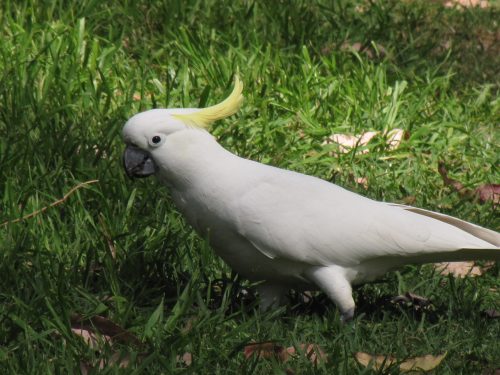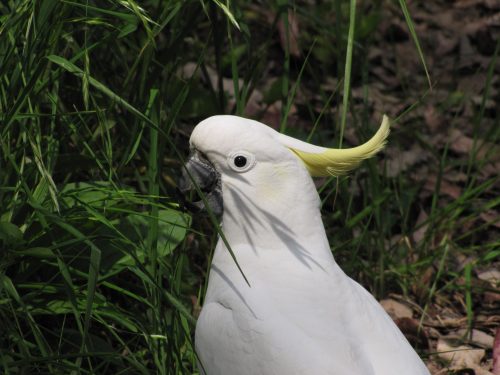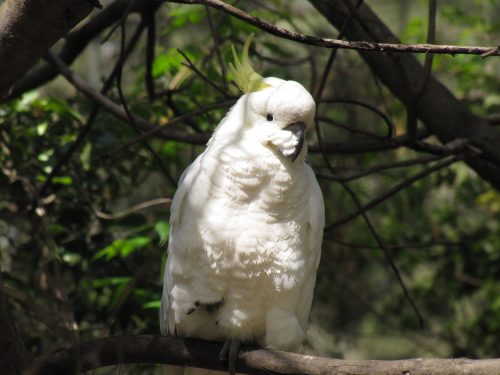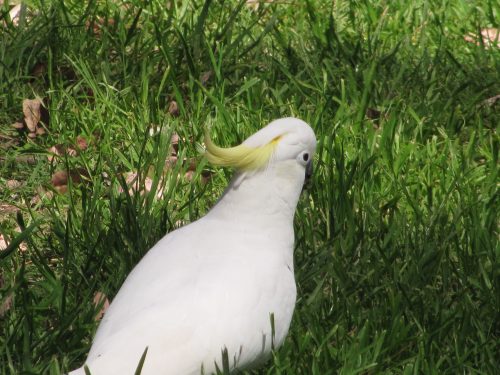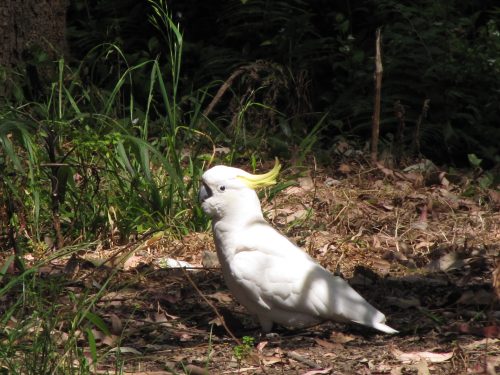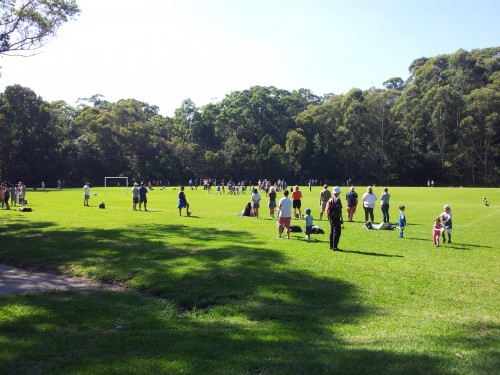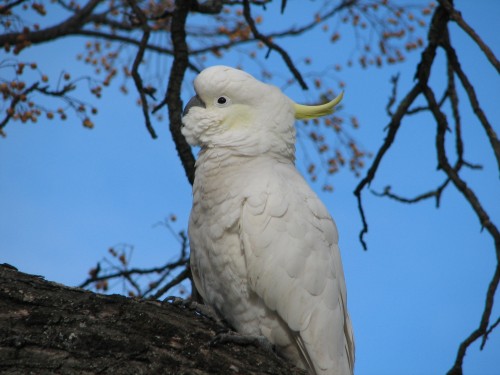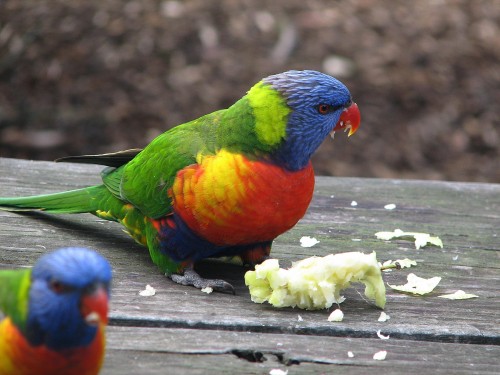Sulphur-crested Cockatoos in Lane Cove
One of Australia’s most recognised and common birds would have to be the Sulphur-crested Cockatoo. I have included a series of photos of this species in this post today. It is found along the north, east and southern coasts of Australia, and in Tasmania. It has been introduced to the south of Western Australia, and in New Zealand.
Large flocks
Throughout its range, it can often be found in large flocks numbering from a few dozen through to many hundreds. In my travels around different parts of Australia, I have observed this species in large numbers, especially where there is an abundance of seed for them to feed on, such as pastures. I have seen large flocks settle in paddocks, making the ground look like snow has fallen. When a flock is feeding on the ground, one or more birds will perch in a tree or on a fence post watching out for any danger. A large flock can also add colour to a dull grey looking gum tree when they all perch together.
Noisy birds
These birds have a very raucous call, and when a flock flies low overhead while calling, it is very hard to carry on a conversation. In some caravan parks we have stayed in where this bird is resident, a noisy flock can be an unwelcome alarm clock, particularly at first light when one wants to sleep in a little. In populated areas, this beautiful bird is often regarded as an unwelcome pest. With such an abundance of food, cockatoos can easily get bored and start chewing on timber work around houses and other buildings. Some of my readers have complained in the past about the destructive nature of this species. There is no easy solution to this problem because this species is a protected bird, like all of our native birds. If you are having a problem with cockatoos, please be in contact with your local National Parks and Wildlife office. It is an offence to destroy them.
Good pets
This species is also a common, long-lived pet for many people. They can be delightful pets and will often learn a range of words and phrases to mimic their owners. I am not familiar with the current regulations on keeping our native birds as pets, so it is best to talk to your local pet shop owners before buying a cockatoo as a pet. They are probably commonly available in pet shops in countries other than Australia. There should be no restrictions on keeping them outside of Australia.
The photos in today’s post were all taken of an individual in the Lane Cove National Park in Sydney. we were staying with our son spending time with our grandchildren during school holidays. On this occasion, we had a few hours break from the children, so we packed a picnic lunch and drove the short distance to the national park. Along the Lane Cove River, there are many lovely grassed picnic areas, complete with picnic tables and gas barbeques for the public to use.
Corellas v Cockatoos
Some people can easily be confused when trying to identify cockatoos and corellas. The three species of corellas in Australia are the Little Corella, Long-billed Corella and the Western Corella. Their ranges often overlap. I have even seen mixed flocks consisting of two species. Corellas are generally a little smaller and all corellas lack the yellow crest of the Sulphur-crested Cockatoos. The calls are also different, with the corellas’ calls being not as loud or as harsh.
Further reading:
- Sulphur-crested Cockatoos up close
- Red-tailed Black-cockatoos
- Gang-gang Cockatoos
- Great Birding Moments #13
- Trevor’s Photos – buy some of my photos on a variety of products such as mugs, place mats, t-shirts and many more.
- Little Corellas at Mannum
- Long-billed Corellas
A little birding at soccer
We are currently staying with our son and his family in Artarmon, a suburb of Sydney. We try to get over here from Murray Bridge where we live at least once and preferably twice a year. While we are visiting I take every opportunity to do any incidental birding. There are significant differences in the range of bird species present here in Sydney when compared to at home.
On the last two Saturdays, we have had the opportunity to accompany our grandson to watch him play soccer. The photo above was taken with my phone at yesterday’s match. It was held on some pitches in Chatswood West, near the Lane Cove River. The match was a little uneven with my grandson’s team winning 10-0. He scored a goal, hit both upright posts and did a creditable job as the goalkeeper for the second half.
While I managed to mostly keep my eyes on the game from my folding chair, I was aware of some bird activity nearby. There were plenty of Noisy Miners nearby, their constant calling forming a backdrop to the noise of the game. My concentration on the game was tested on occasion when numerous raucous Sulphur-crested Cockatoos came wheeling overhead, landing in the trees surrounding the pitches.
After the game my wife and I found a comfortable garden seat near the playground adjacent to the soccer fields. This area was surrounded by many trees and bushes. While we sat there we were entertained by two Rainbow Lorikeets working at a hollow in a branch of a nearby tree. Within a few minutes a small flock of about 5 or 6 Sulphur-crested Cockatoos came into the same tree, squawking very noisily. The lorikeets vacated the hollow, their protesting screeches making the cockatoos know that they were far from happy. Several of the cockatoos inspected the hollow before leaving it. The hollow would have been too small for the much larger birds.
Other birds seen in the vicinity include:
- Australian Magpie
- Magpie Lark
- Common Myna
- Laughing Kookaburra
- Welcome Swallow
Now for the sad news.
I forgot to take my camera. The above photo was taken with my phone, but taking bird photos requires a much better camera setup than that. Had I remembered to bring my normal camera from home I would have managed to get some great shots of both the lorikeets and the cockatoos. The cockatoos had their yellow crests up on display for much of the time that we observed them. As well as those two species displaying for us, we also had a Laughing Kookaburra flying down to the lawn just in front of us to gobble up a tasty morsel for lunch.
For a moment, I thought I would be able to use my wife’s camera which was in the car. On opening up here camera bag, we found that the batteries were flat, including the spare set. Sigh. We will just have to return there while we are still here. In the meantime, I have included several photos of cockatoos and lorikeets taken elsewhere.
A short non-birding holiday
I am sorry about the lack of posts here in the last few weeks. I’ve been busy, distracted, somewhat unwell, and occupied with other tasks. Life happens.
Last week we hitched up the caravan for a four night mini holiday in Victor Harbor on the coast south of Adelaide. We usually head down there for a few days this time of the year so my wife can attend the CWCI Convention there. This convention is enjoyed by Christian women from all over the state and even some come from interstate. Meanwhile, the respective husbands, including yours truly, sit around in the caravan park talking about all manner of things and generally solving the world’s problems. Sometime we even gather up the energy and go for a walk.
This time around it was different for me. I was recovering from dental surgery and was not feeling much like walking. I did a lot of sleeping and reading. I also had long chats to some of the men on some quite deep topics – about life, the universe and everything. It didn’t leave much time for birding.
I just made a sketchy list of the birds seen or heard from where we were in the caravan park. Not a great list but I was aware of a few birds. Probably the highlight was seeing four Yellow-tailed Black-cockatoos flying low overhead. Quite a nice species to add to my list for the weekend. I didn’t have the camera on me at the time. In fact, the camera didn’t even come out of its case all weekend. Now that’s unusual for me.
There was one other nice sighting. On the way home we saw about 50 Cape Barren Geese just south of home. Here’s a photo of one I prepared earlier.
Further reading:
A bird in the hand
I had to laugh at a line in a regular column in our daily newspaper this morning.
‘A bird in the hand is safer than one overhead.’
I disagree.
Yes – sure – I’ve been pooped on from above on a number of occasions. The most memorable of these was twice in the space of a few minutes while exploring the streets of Kathmandu in Nepal.
But having a bird in the hand is no guarantee of safety. I’ve handled a few birds over the years, including in aviaries and birds in our garden stunned from flying into windows. I’ve been pooped on the hand more than once from nervous birds.
Most birds have rather sharp claws and small parrots have needle like bills. I have never handled a larger parrot, one such as a Galah, without some form of protection for my hands. I reckon that our large black cockatoos would do some serious damage to a finger given half a chance. I prefer not to test out that theory.
Being pooped upon is only one of the hazards of being around birds. Some birds are very cantankerous given the right circumstances. A few years ago I wrote a long article about dealing with aggressive bird behaviour. It has proved to be one of the most popular articles on this blog.
Happy birding.
New bird species for our garden list
I was sitting outside yesterday morning doing some reading. (Oh the joys of retirement.)
I was suddenly aware of an unusual bird call. After having lived for over 25 years in the same house one’s ears become attuned to what bird calls are normal for this area and anything unusual immediately gets my attention.
I walked warily around the corner of the house to find two Sulphur-crested Cockatoos in the large mallee tree next to our garage. This cockatoo is a common bird in many parts of Australia, but this was the first time I’d seen this species in our garden. After so many years I don’t often get the chance to add a new species to my garden list.
After I managed several photos they decided they’d posed enough for me and flew off to the eucalyptus trees in our neighbour’s front yard. Later in the morning I heard them squawking raucously as they flew off.
Sulphur-crested Cockatoos are very common in the Adelaide Hills and the Adelaide metropolitan area but I’ve never recorded them here in Murray Bridge. The nearest I’ve seen them is in Strathalbyn, about a half hour drive SW of here.
